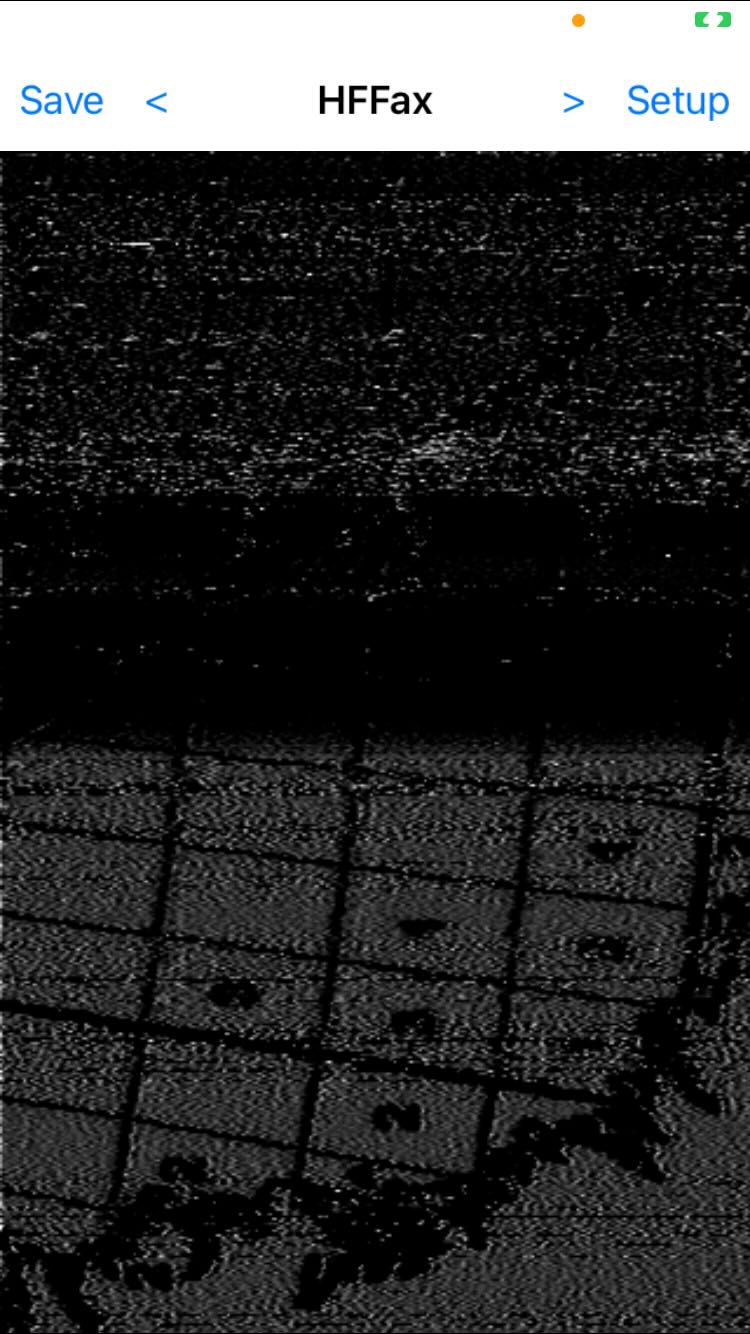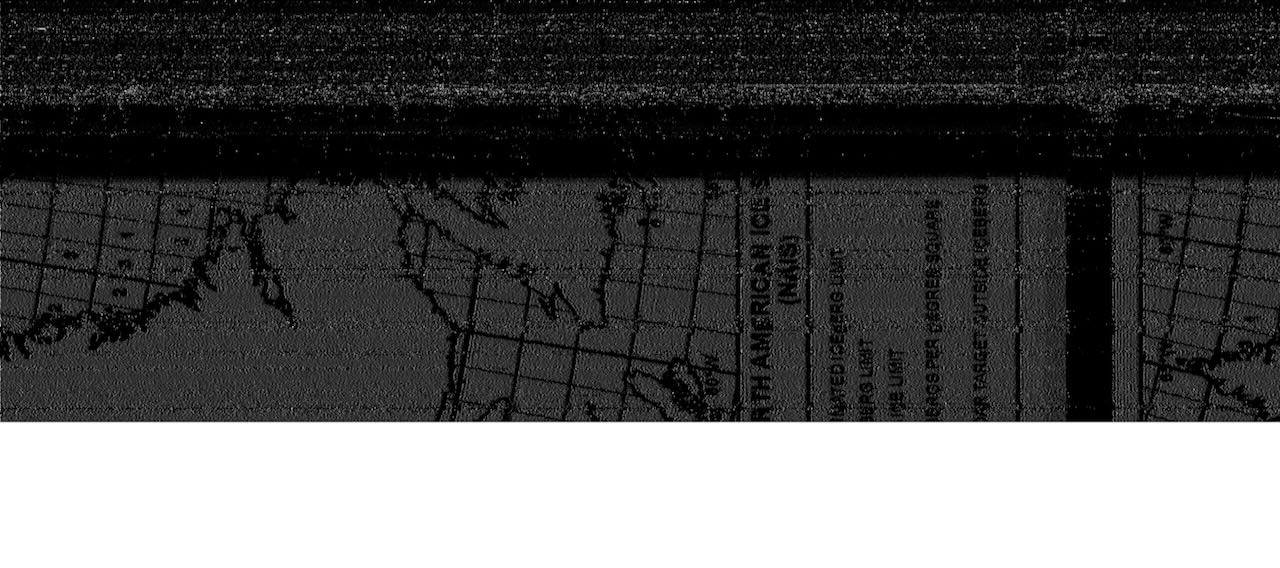Many thanks to SWLing Post contributor, John Johnson, who writes:
Well, based on this post from Carlos Latuff–QSL: Australian Radiofax Received in Brazil–I got interested in HF weather fax decoding. I asked how to do it and got an answer but did not find a linked post that would help.
So as usual a wikipedia is helpful: WEFAX – Signal Identification Wiki
Which led me to realize… I already owned the Black Cat Systems decoder in my iPhone, but alas had never tried to use it!
So I reinstalled the HF FAX program. It had been included in a package of iPhone ham software programs I had previously purchased. I then searched the frequencies linked here: Marine Weather Broadcasts from the USCG
And soon after on 12179kc on my D-808 around Noon eastern time on 11/4/23 was decoding my first partial wx fax from Boston, I believe:
I then started fine tuning the D-808 and as you can see the fax quality began to improve significantly…
Alas the signal ended very abruptly, before I could perfectly tune it… I never received a complete fax but this was a fun radio exercise and I will keep at it.
WxFax (this is my name for it) reminds me of my NDB beacons. Both are older tech that appear to be rapidly disappearing. Just last night I was happy to tune two new but weak Canadian LW beacons from my Michigan location on my D-808. Alas I then refreshed the dxcentre NDB list–at: https://www.dxinfocentre.com/ndb.htm–only to find that I would be losing 3 relatively strong beacons to decommission within weeks! Such is the life of an LW NDB chaser in the year 2023.
Thanks to Carlos for giving me something else to chase on SW HF!
John Johnson (N8ELK)
This is brilliant, John! The more you work with the app and reception, the better you’ll get at clear decodes. It’s a skill you’ll build very quickly. Thank you for sharing this!



Hey John, welcome to the club!
🙂
I love to spend a time receiving radiofax from around the world and since radiofax will be soon or later be replaced by modern technologies (See New Zealand’s MetService for example) better enjoy it while it’s still available.
Greetings from Brazil.
Thanks Carlos!
I read your post and was immediately curious about how to decode the radio fax. It didn’t take long to Google up some easy possibilities and I found that I already had software capable of doing it.
It’s funny all the “noises” you hear out on the waves over many years of listening… and you wonder about them and then tune past. I have “heard” fax machines for many years and I know I must have tuned into these radio fax broadcasts over the years… but your post made me put 2+2…
Thanks again for giving me a fun radio tip.
Happy DXing!
Carlos, I also wanted to tell you that I really love your art. Your drawing is magnificent… I wish I could render nearly as well as you do.
Another interest of mine is stamp collecting and I have a fascination with inventions of Thomas Edison as well. I have an Edison cylinder phonograph I fixed and like to crank up sometimes. One thing I have acquired that brings those two interests together is a beautiful postal cover hand drawn by Dorothy Knapp that depicts Edison in profile. Dorothy was a fine artist in her own right and rendered hundreds of beautiful postal covers over many decades. Your drawings remind me of hers sometimes. You both have that gift.
I look forward to your next post and to see what your pencils come up with also!
Thanks for your kind comments, John.
I’m always trying to combine radio reports with cartoons.
I think it’s a great mix.
I’ve always been a fan of the fax machine, I used to fax cartoons to TV talk shows in the 90s. Fax was a powerful communication tool for a cartoonist. However, in my mind, faxes could only be received via telephone. Then, in 2020, during the COVID-19 pandemic, when I was spending most of my time listening to shortwave, I came across a strange, rhythmic signal. I asked a DX colleague, Ivan, from Sorocaba, who said that that signal could be local interference or radiofax. And I was amazed! Fax via radio??? My receiver at the time didn’t have SSB filter, so the decoding was never very good. Then I bought an Xhdata D808 and started receiving images with better quality, recording the audio on a digital recorder and playing it on a laptop using programs like MixW to decode. I never tire of being surprised by radio signals that turn into images. Today I continue to receive radiofax, but via the Android app. The app is HF Weather Fax, which is from 2017, and every now and then it stops working as the Android version today is more modern and sometimes causes incompatibility. In the near future I should buy a laptop just to receive radio faxes. I’m glad my posts encouraged you. I am an undeniable fan of this ancient but fascinating radiofax technology.
Greetings from Brazil, my friend.
An interesting article. I did 3 tours at USCG CAMSLANT and am a USCG COMMCOM Plankholder. FYI, on the East Coast, there are 3 transmitter sites and 3 receiver sites, NMF, NMN and NMA along with one in New Orleans (Belle Chase) NMG. There are also 2 NAVTEX (518 khz) sites, NMR in Agudilla, PR and NME in SC. It NME was sited in Charleston harbor but was moved about 5 years ago. COMMCOM is the controlling facility and is located on the campus of Naval Security Group, Northwest which is on the VA/NC state line. In fact, the state line runs through one end of the facility. COMMCOM runs all the CONUS the sites remotely to include what was COMMSTA Kodiak, NOJ. We also run NMT a seasonal facility in Barrow, AK used when the Northwest Passage is navigable. Last time I checked, NMT is a SAR facility co-located with an AIR Station that, last is also seasonal.
Copying WEFAX and NAVTEX is a lot of fun and quite a challenge.
Test Reply
WeFAX is fun.
I’ve been decoding WEFAX for years using Blackcat Systems software. I live near Minneapolis, Minnesota. NWS WEFAX are a frequent decode. Occasionally I’ve been able to decode German WEFAX on 13.882.50 in the afternoon here. Today I had a first I was able to decode WEFAX from Chile around 2300 UTC on 17146.40. I was able to receive one chart and a satellite image.
The hunt continues.
Keep at it! 🙂
The dark background ( instead of white) means you are tuned to low in Frequency.
You may need to use a wider bandwidth filter on the D-808 and tune slowly while receiving until the lines ate black (ish) & the background is white(ish)
Once you get it right once it will be easy , as you then know what it should sound like!
Thank you sir!
Yep I am making those connections as I have been tweaking over the weekend. I now have some much better examples coming through. I also strung up my old Sony AN-LP1 antenna and as the noise floor drops I see huge quality improvements too.
Having pretty good luck on 12479kc USB Fine tune on D-808 of +50 but I am still tweaking…
I also am picking up on the tone recognition too, relative to the tuning. Music to my ears. I have always enjoyed the musicality and rhythm of CW…. so…
I have been thinking of adding some of these fax broadcasts to my kids playlists just to see if they notice! ?